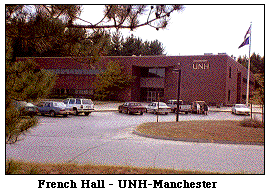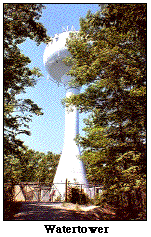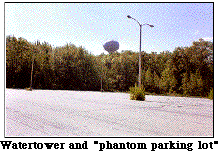PLANNED ACQUISITION OF THE
HACKETT HILL PROPERTY BY MANCHESTER
 In the 1960s, the
University of New Hampshire, whose main campus is located in Durham,
NH, opened a "branch" of the University in Manchester. Initially, the
branch was known as Merrimack Valley College. It was established on
property located in the northwest corner of the city, and consisted
of a single building (French Hall), positioned adjacent to Hackett
Hill road, which runs towards the northwest from Route 3A. In French
Hall, a spacious, modern building which contains classrooms, a
library, offices, computer labs, a cafeteria, etc., courses were
offered that would lead to a two year Associates Degree.
In the 1960s, the
University of New Hampshire, whose main campus is located in Durham,
NH, opened a "branch" of the University in Manchester. Initially, the
branch was known as Merrimack Valley College. It was established on
property located in the northwest corner of the city, and consisted
of a single building (French Hall), positioned adjacent to Hackett
Hill road, which runs towards the northwest from Route 3A. In French
Hall, a spacious, modern building which contains classrooms, a
library, offices, computer labs, a cafeteria, etc., courses were
offered that would lead to a two year Associates Degree.
 Within
a few years, there were plans to expand
UNH-Manchester. In order to build a true campus,
the 830-acre Hackett Hill site was purchased. Proposals were also
floated that the new academic buildings could be complemented by
buildings which would accomodate a larger student body.
Within
a few years, there were plans to expand
UNH-Manchester. In order to build a true campus,
the 830-acre Hackett Hill site was purchased. Proposals were also
floated that the new academic buildings could be complemented by
buildings which would accomodate a larger student body.
At this point in time, a
road was built uphill into the interior of the property. At the
road's termination, a large parking-lot complex (which is now known
as the "phantom parking lots") was built near a massive water tower.
This "infrastructure", which includes sewer lines,electrical lines,
etc., has never been used, since the proposed buildings were never
constructed.
In 1986, UNH opened a second "branch" in the
Manchester millyard by leasing space from the city in renovated mill
buildings. This locale became known as "University Center". It was
also equipped with classrooms, offices, labs, etc., as well as an
auditorium. UNH-Manchester students took classes at both the "hill"
and the "mill" campuses. Meanwhile, academic expansion occurred and
eventually several 4 year programs became available.
In recent years, it became apparent that
UNH-Manchester would fare better if its two campuses were
consolidated. The downtown area appeared more appropriate for this
purpose. It could be reached by public transportation, and moreover,
the millyard area and downtown Manchester were both undergoing
considerable improvement and revitalization.
In the fall of 1998, a purchase-sale arrangement
was discussed between the City of Manchester and UNH. According to
this plan, the city would purchase the Hackett Hill property from
UNH. The University, in turn, would purchase the mill building space
needed for its academic programs and would lease parking spaces from
the city. French Hall and the 8.8 acres on which it is located would
remain the property of UNH for 2 years while a
transition of Hackett Hill programs to
University Center was underway.
BACK TO INTRODUCTION TO
PART I
FORWARD TO THE NATURAL HISTORY OF
HACKETT HILL
HOME
 In the 1960s, the
University of New Hampshire, whose main campus is located in Durham,
NH, opened a "branch" of the University in Manchester. Initially, the
branch was known as Merrimack Valley College. It was established on
property located in the northwest corner of the city, and consisted
of a single building (French Hall), positioned adjacent to Hackett
Hill road, which runs towards the northwest from Route 3A. In French
Hall, a spacious, modern building which contains classrooms, a
library, offices, computer labs, a cafeteria, etc., courses were
offered that would lead to a two year Associates Degree.
In the 1960s, the
University of New Hampshire, whose main campus is located in Durham,
NH, opened a "branch" of the University in Manchester. Initially, the
branch was known as Merrimack Valley College. It was established on
property located in the northwest corner of the city, and consisted
of a single building (French Hall), positioned adjacent to Hackett
Hill road, which runs towards the northwest from Route 3A. In French
Hall, a spacious, modern building which contains classrooms, a
library, offices, computer labs, a cafeteria, etc., courses were
offered that would lead to a two year Associates Degree.Within a few years, there were plans to expand UNH-Manchester. In order to build a true campus, the 830-acre Hackett Hill site was purchased. Proposals were also floated that the new academic buildings could be complemented by buildings which would accomodate a larger student body.
